The peak of the Soviet heavy tank line
The IS-3 was only superficially a major departure from previous heavy tanks, with a lineage including the KV-1 (1939), KV-1S, KV-85, IS-85, IS-1 and the IS-2. The IS-3 had a new front hull and a new turret shape which became the trademark of all postwar Soviet tanks to date. Because of multiple issues, production was cut short and it was followed by the ponderous IS-4, the prototypes IS-6, IS-7 and, finally, the IS-10 (rebaptised T-10 after the death of Stalin). Because of poor mobility the Russians reached the same conclusions as their western counterparts regarding heavy tanks. This class of vehicles was abandoned in the West as well after 1953, after the first cruiser-derived MBTs had revealed a new way.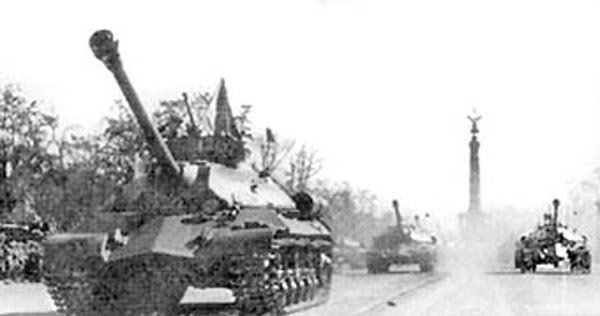
JS-III in a parade on the Brandenburg gate avenue, Berlin, 1945.
The "pike"
As soon as the first IS-2 rolled off the factory line, decision number 5583 on 8 April 1944 asked for a replacement, designated Iosif Stalin 3. The same ChTZ design team was at first responsible for the design of the prototype (Object 703) in Chelyabinsk. As a note another vehicle also received the designation IS-3 (Object 244), a regular IS-2 fitted with the D-5T-85-BM long barrel 85 mm (3.35 in) gun, which had far greater velocity than the 122 mm (4.8 in). The project was later cancelled. The new IS-3 retained the same gun as the IS-2, but the protection was entirely revised. The design was eventually carried out in a competitive manner between Plant Number 100, led by Zh.Ya. Kotinym and A.S.Ermolaevym, and the Chelyabinsk Kirov Plant design bureau, headed by N.L.Duhovym and M.F.Balzhi. This resulted in two designs.G.N.Moskvin and V.I.Tarotko from Plant n°100 decided not to deviate greatly from standard production design of the IS-2, but the upper front part of the body was made of two connected and highly inclined sloped armor plates meeting at a large angle. On top of the plates was a triangular shaped roof, inclined at 7°. Directly above the driver the was an escape/access hatch. Subsequently, this nose design was dubbed "pike nose", and later the tank itself was called "Pike" (Shchuka) by the crews.
On the other hand, CHKZ's Zh.Ya.Kotin chief engineer, using experience from the experimental "Object 244", "Object 245" and "Object 248", redesigned the turret in a simpler way, largely hemispheric, lower but with considerable slope at any angle. But in both cases, the hull machine gun was excluded, liberating space, allowing more judicious interior management and improving the frontal armor plate layout.
The prototypes
The first prototype began the first running tests on 28 October 1944, on the Kalmakskom proving grounds, but revealed some serious flaws and had to be returned to the factory for modifications. The tests were resumed in November on the usual 1000 km (620 mi) trip, but again, revealed serious problems, in particular with the transmission and engine. The second prototype swapped its B-11 diesel for a B-2-IS, but the chassis was unmodified, although slightly longer. The running tests were performed from 18 to 24 December 1944, but also revealed some limitations which needed to be fixed. Meantime, CRI-48 specialists studied both designs and suggested to combine their particular advantages, namely the "pike" frontal armor of Plant 100 and the new dome-like shaped turret design of CHKZ. The final project was named "Kirovec-1" and CHKZ director I.M.Zaltsman expected to deliver this new model before the final Victory. By the order number 729 of December 16, 1944, the plant was to provide ten pre-series machines, from which 10 were to be delivered before the 25th of January, 1945.Design
The chassis was left virtually unchanged, although the design incorporated welded two-parts, reinforcements for the 6 all-metal usual double rollers with individual torsion suspension, 2 idlers acting as front guides and the rear drive wheels with removable crowns of 14 teeth. However, as shown by superposed plans, the gap between the individual boogies was slightly higher. There were also three double return rollers per side. The tracks were also unchanged, still 160 mm (6.3 in) wide. The big change however was found in the front hull layout, with a "pike nose" counting two inclined plates at a greater angle to the vertical. The top was given a backward-slope, wide shoulder straps to fit the tower. The hull sides were also largely inclined and well-sloped, thus eliminating the previous usage of storing equipment on the large mudguards, although they still could be stored inside. At the rear the power transmission unit was made more accessible and the driver was relocated on the center axis of the tank. His top hatch was equipped with vision devices and he also had access to an extra escape hatch in the bottom floor.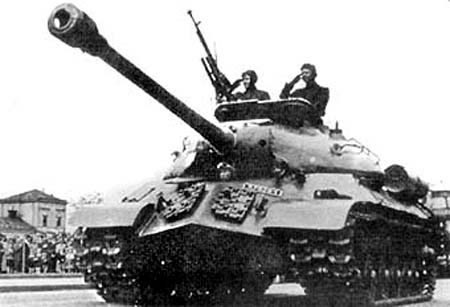
The other change from any previous designs was the turret. It was hemispherical, bowl-shaped, larger than the width of the tank itself and presented a pronounced tumblehome form. This shape, later simplified, ended as the trademark of all Soviet Cold War tanks, and its still recognizable today in the latest Russian MBTs. The front part of the turret was narrower, housing the gun mantlet in a single piece (not welded on like previous turrets). At the rear was placed an oval roof two-piece hatch. The commander cupola was gone, but a new ring mount for the DSHK heavy AA machine-gun was designed for a better angle of fire. On the right were installed viewing periscopes MK-4 and the commander\'s hatch received a TPK-1 viewing device. Another MK-4 was placed at the top left of the tower, for the gunner. The turret was electrically traversed at a maximum turning speed of 12 degrees per second. Ten handling bars were welded-on, two horizontal in the middle and four vertical to the turret rear, to carry soldiers. This particular design had two backdrops. First it significantly diminished the working headroom, especially for the loader, and the low-profile also diminished the maximum depression of the main gun.
Armament comprised the same 122 mm (4.8 in) gun D-25T model 1943, 48 caliber, with a two-chamber muzzle brake and horizontal semi-automatic breech. The sighting range (with a telescopic sight TS-17) was 5000 m (5450 yards). However the rate of fire was 2-3 shots per minute, still largely inferior to German and western tanks in general. Moreover, the split ammunition types consisted of only 28 rounds, 18 HE and 10 AP shells. There was a single DT secondary machine-gun next to the gun in a fixed cast encasing, firing tracers (954 rounds in 15 "cheesebox" magazines), and the DShK 300 rounds in strips of 50.
The 12-cylinder 4-stroke V-type diesel engine V-2 IS-3 gave 520 hp at 2200 rpm. It was fed by two internal 450 liters tanks, with a safety obturation system activated from inside in case of fire, and the usual external four side tanks, plus two small tanks on the rear slope. Usually a steel cable was held there too. The old transmission had a dry multi-plate friction clutch, 8-speed gearbox with dual and dual-stage planetary rotation mechanisms. The floating brakes had cast iron steel belts. The final drives had simple step-down gears and planetary gears. Internal communication was made possible by a TPU 4bis intercom and external by a F10 RC-26 radio.
Active service
Since the IS-3 differed in many points from the previous designs, for the first time a major retooling was needed. This took time, and only in May 1945 the first three pre-series vehicles rolled out of the factory, to be thrown immediately into action in Germany, in the hands of an independent Guards Battalion. However, when they arrived, peace had already been signed. Rumors of a fighting en route with an isolated Abteilung of Jadgpanthers after the surrender is left unconfirmed by most sources. By the time of the invasion of Manchuria in August, many more IS-3s were ready, but there is little evidence that they did participate in these events. The IS-3 was a Cold War tank, of the same generation as the British Centurion and American Pershing. All three were conceived to fight the latest German tanks, but ended on opposite fronts and had a long Cold War career.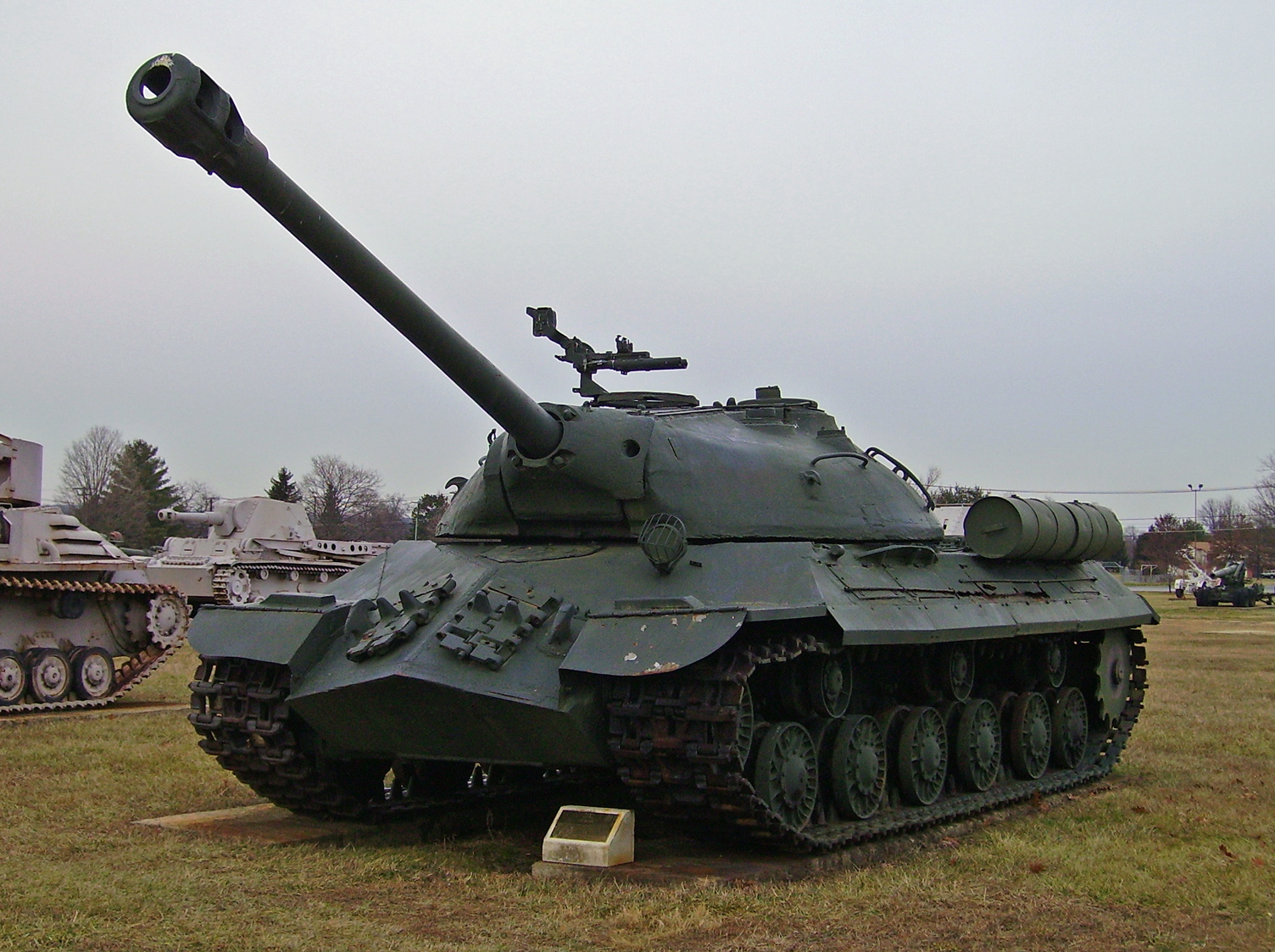
Stalin however had other plans for these tanks, paraded proudly on the 7th of September 1945 during a military parade in Berlin. They all belonged to the 71st Guards Heavy Tank Regiment of the 2nd Guards Tank Army. They also paraded first in Soviet Union on November, 7, 1946, and in the Red Square the next year. The experts evaluation of the IS-3 was quite higher than the real capabilities of the tank since the third Stalin was plagued by defaults and never-fixed issues left from an antiquated and troublesome transmission inherited from the KV-1, new issues caused by the adoption of an ill-adapted heavy gun (with too little ammo carried and a very low rate of fire). Assembly too was problematic, the rear hull side elements welded around the engine compartment having tendencies to crack open. Resulting from this, the production was discontinued in the summer of 1946, and eventually stopped at the 2311st vehicle.
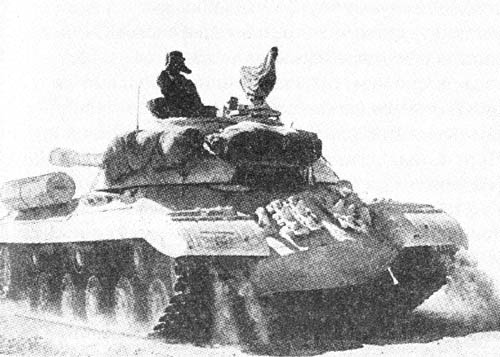
A first step towards modernization (IS-3M) was taken in 1948, with reinforced brackets for the engine, a modified gearbox mount, strengthened under-turret plate, improved design of the main clutch, better sealing and final drive rollers. The radio was also modernized, but the weight eventually rose to 49 tons. A second wave of upgrades came in the fifties, with an increased body rigidity through the introduction of rigidity bars in the rear hull section and bracing in the floor and bottom of the gear box. The machine-guns were replaced by the DShKM and DTM. A new rotary commander\'s hatch cover was provided while night vision device TVN-2 was mounted for the driver. The engine was also changed for a B-54K-IC giving 520 hp, and serving a 2-VTI dual-purpose air cleaner. Other modifications included a modified lubrication system, cooling system and NICS-1 heater with electric drive, reinforced bearing for the rollers and idlers, and two-wire circuit of emergency lighting for the electrical system. The shot control system was entirely modernized, R-113 radio and P-120 intercoms fitted. During the seventies-eighties, the IS-3M were gradually put into active reserve, then in depots.
The IS-3M participated in the Odessa events in November 1948, and later in the Hungarian revolution of 1956 (several lost in Budapest). Other Warsaw Pact nations received the IS-3, like the Poles (two for trials), Czechs (one for the military school), and "affiliated nations" in the Middle East, like the Egyptians. Egyptian IS-3Ms (around 100 IS-3s plus around 60 IS-3M) took part in the 1967 War, some being destroyed en route by IDF fighter-bombers dropping napalm. These were part of the 7th Infantry Division, holding the position in the Khan Yunis-Rafah line, and another 60 tanks operated with the 125th Armored Brigade stationed near El Kuntilly. Many were simply captured in relative good order and bolstered the young IDF forces after the war, being turned into tractors, ARVs or concrete pillboxes on the "Bar-Lev Line" along the Suez Canal, or near Port Saïd, prior to the 1973 War. Many were returned to their former owners after the war.
IS-3 links and references
The IS family on WikipediaOn WWIIvehicles.com
On Battlefield.ru
YouTube "failed tanks" series: The IS-3
IS-3 model 1944 specifications |
|
| Dimensions (L-w-h) | 9.85 x 3.09 x 2.45 m (32.32x10.14x8.04 ft) |
| Total weight, battle ready | 45.7 tons |
| Crew | 4 (commander, loader, gunner, driver) |
| Propulsion | V-2-1S diesel V12 600 bhp (450 kW) |
| Speed | 40 km/h (25 mph) |
| Suspensions | Transverse Torsion arms | Range (road/off road) | 185 km (115 mi) |
| Armament | Main: 122 mm (4.8 in) D25T gun
Secondary: 12.7 mm (0.5 in) DShK anti-aircraft machine gun 1 or 2x7.62 mm (0.3 in) machine guns |
| Armor thickness | 60 to 175 mm (2.36-6.89 in) |
| Production | 2311 |

Iosif Stalin 3 model 1944, from an Independent Guards Heavy Tanks Regiment, Berlin, May 1945.

IS-3 from the 71st Guards Heavy Tank Regiment, Berlin parade, September 1945.

IS-3M at Odessa, 1948.

IS-3 with a surplus, roughly cast turret, 1948.

IS-3M at the Chinese border, 1972.

IS-3 during the 1956 Hungarian revolution.

One of the two Polish IS-3 tested after the war. Both are preserved in static display.

Egyptian IS-3M from the XXth Infantry Division, War of 1967.
Gallery
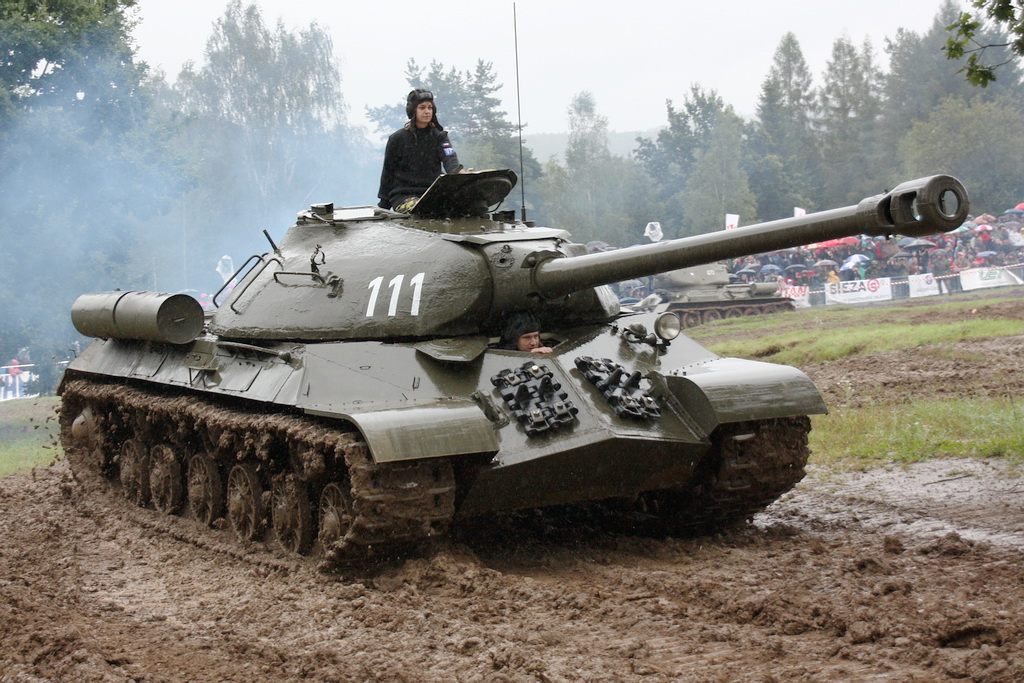
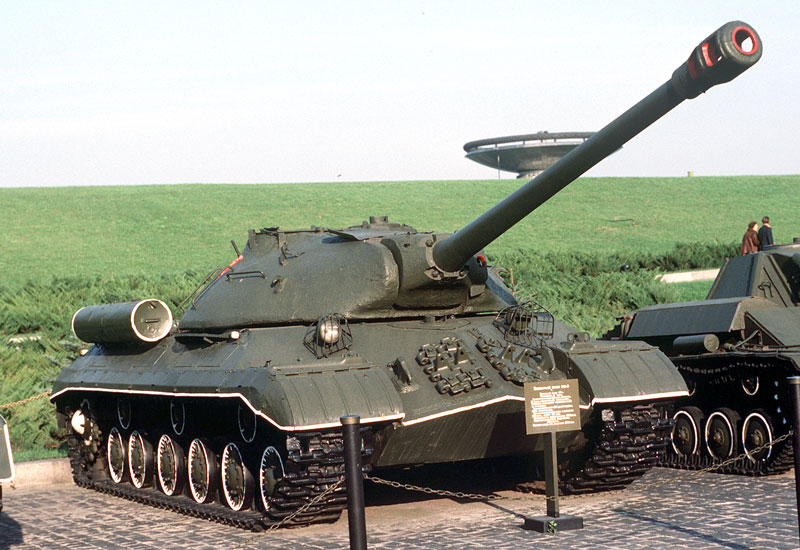
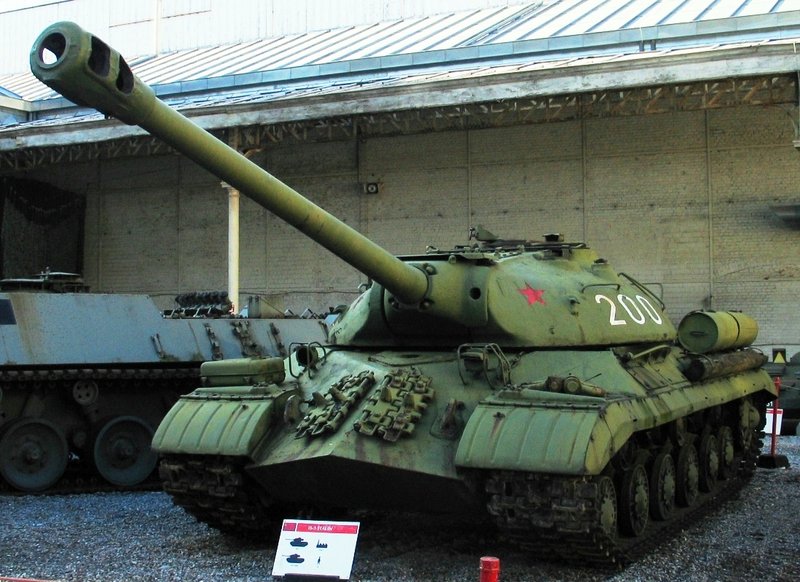
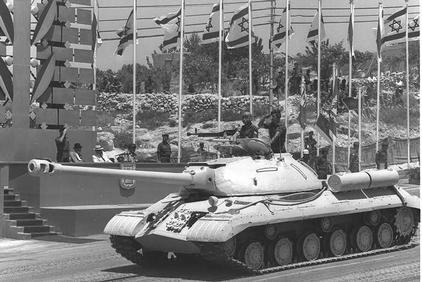
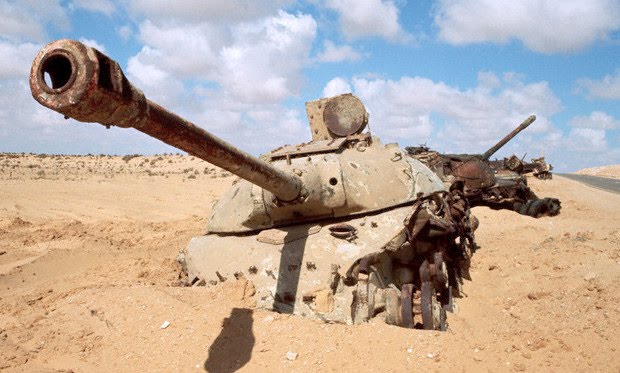
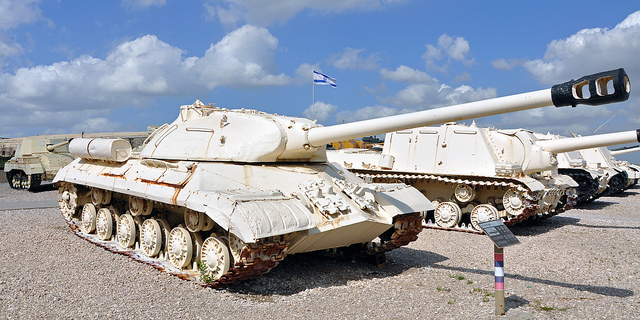
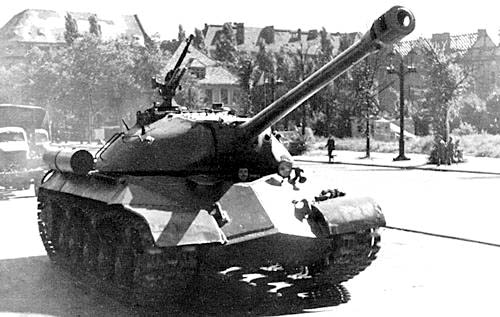
Video
I do not own the rights to this video or soundtrack. They are displayed solely for educational purposes.

WW2 Tanks




























WW2 tanks posters

All Tiger tanks liveries.

Panther liveries and variants

WW2 Armour - All tanks











Tanks aces and single tanks series

Find more there

Museums, Movies, Books & Games
The Tanks and Armor in pop culture
Tanks and armored vehicles in general are only really grasped when seen first person: The mass, the scale, it's all there. Explore also the way tanks were covered in the movie industry, in books and in video games.Movies:
Best tanks movie on warhistoryonline.com
On imdb.com
On bestsimilar.com/
miltours.com
liveabout.com/
watchmojo.com
Video Games:
pcgamesn.com
historyhit.com
levvvel.com
vg247.com/best-tank-games
mmobomb.com/
alienwarearena.com

